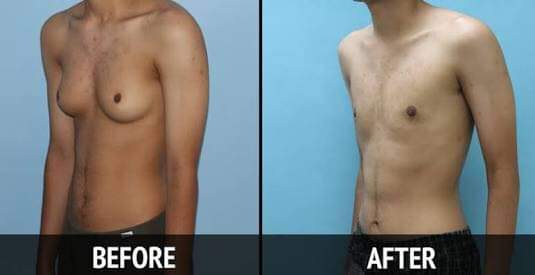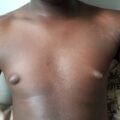What Is Gynecomastia?
Gynecomastia refers to a condition that makes breast tissue swell in boys and men. It can happen when the balance of two hormones in your body is thrown off. If you have enlarged breasts because of fat deposits, you have a different condition called “pseudo gynecomastia”.
Although breasts don’t develop in men the way they do in women, all boys are born with a small amount of breast tissue. Boys’ bodies mostly make a hormone called testosterone, which guides their sexual growth during puberty. But males also make some estrogen – the hormone that steers sexual growth in girls.
When a boy is going through puberty, or when an older man’s body makes less testosterone, the balance of the two hormones changes.
Sometimes when that happens, a higher percentage of estrogen causes male breast tissue to swell. Up to 70 percent of boys in early to mid-puberty experience gynecomastia because of the normal hormonal changes that occur during puberty. Gynecomastia is also common among middle-aged and older men. In this population, up to 65 percent of men are affected.
What causes gynecomastia?
Gynecomastia is usually a benign (noncancerous) condition. It may be linked to many different causes of hormone changes. In many cases, the cause isn’t known.
Gynecomastia is often caused by changes in levels of the female hormone (estrogen) and the male hormone (testosterone). But it can be caused by other things as well.
Gynecomastia can be a side effect of certain medicines, such as antidepressants, antibiotics, chemotherapy, prostate cancer medicines, ulcer or cardiovascular medicines. Illegal drugs, such as anabolic steroids, heroin, or marijuana can also cause gynecomastia.
Some diseases and medical conditions may also cause gynecomastia. These include:
- Injury or trauma
- Kidney disease
- Liver diseases
- Lung cancer
- Obesity
- Some conditions that a baby is born with (congenital disorders)
- Testicular cancer
- Thyroid disorders
- Tumors of the adrenal glands or pituitary gland
Newborn babies may have a short-term form of gynecomastia. This is often because a mother’s estrogen stays in a baby’s blood for a while after birth.
Gynecomastia is not linked to breast cancer. It is rare that men get breast cancer. But your provider may do some tests to rule out breast cancer.
How to identify gynecomastia or chest fat
You identify this condition by looking for true gynecomastia symptoms. The main symptom of gynecomastia is the enlargement of male breasts caused by the growing size of the glandular tissue, as opposed to the presence of fat deposits. This makes the breasts feel firm or rubbery instead of fatty. In the majority of cases, the condition affects both breasts, although the growth may not be even at all times. Gynecomastia affecting only one breast is rare, but also possible. The patient may also feel mild to moderate breast pain or tenderness, but severe pain is generally not considered a symptom of the condition.
Other than those mentioned above, the condition does not cause any other symptoms. If a male patient experiences breast growth in only one breast that is accompanied by other major symptoms such as nipple discharge, nipple retraction, skin dimpling, and enlarged lymph nodes in the underarms, these may be signs of male breast cancer.
Gynecomastia does not cause serious health effects that require treatment unless it is caused by an underlying medical condition. In most cases, men suffering from this condition seek treatment because it negatively affects their self-esteem and self-confidence. The appearance of their breasts may cause them to become conscious about their bodies, and this may have some effects on the way they live their lives and interact socially. In severe cases, it may lead to depression or social anxiety.
What is a Gynecomastia Pinch Test?
A Gynecomastia pinch test is a physical exam conducted to determine whether the condition is true gynecomastia or pseudo gynecomastia. Clinically, gynecomastia is diagnosed by finding subareolar breast tissue of 2 cm in diameter or greater.
During a gynecomastia pinch test, you will be asked to lie down on your back while the doctor will use his or her forefinger and thumb to examine your breast tissue. If there is a rubbery or firm mass of disk-shaped tissue under the nipple, the condition is classified as true gynecomastia. If no such tissue exists, a gynecomastia pinch test can conclude that the diagnosis is pseudo-gynecomastia.
If you feel uncomfortable with the shape or size of your breast, you can visit your doctor or healthcare provider for an early-stage gynecomastia pinch test, which can confirm whether you have true gynecomastia or pseudo-gynecomastia.
Additional tests to diagnose gynecomastia and help determine any underlying causes may include:
- A mammogram to obtain a radiologic picture of the breast tissue
- Endocrine hormone tests to assess hormone levels.
- Blood tests to evaluate kidney, liver, and thyroid function.
Treatment of gynecomastia
For any man who desires to reduce their enlarged breasts, male breast reduction surgery can help. During a male breast reduction procedure, glandular tissue, fat, and skin are removed from the breast to help create a flatter, more masculine chest contour.
Liposuction can remove excess fatty tissue. It involves inserting a small tube through an incision. Excision involves cutting out tissue with a scalpel to remove excess glandular tissue. This will normally leave a scar around the edge of the nipple. If a major reduction in tissue and skin is necessary, the incision and the scar will be larger.
After surgery, the chest will be bruised and swollen, and the person may have to wear an elastic pressure garment to reduce the swelling.
It will normally take about 6 weeks for people to return to a normal routine. Complications from surgery are rare. They include insufficient breast tissue removal, uneven chest contour, and reduced sensation of one or both nipples.
The physical results of this procedure are often incredible, but the emotional effects can be just as significant. It’s natural for men to experience a dramatic boost in self-esteem following their surgery. As an added bonus, the fat that is removed during male breast reduction can also be used to help sculpt the pectoralis muscle if the patient wants this.






